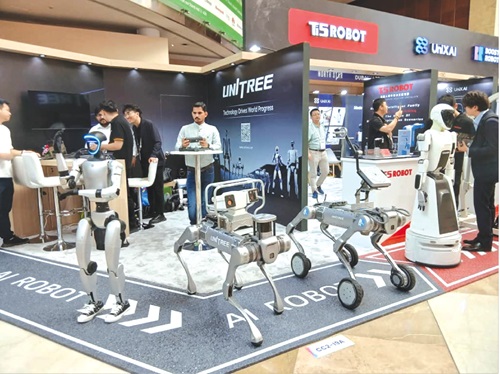Robots — machines that can make work easier for industries — drones, technological advancements in transportation, and more were on display at this year’s GITEX Global 2025, organised by the Dubai World Trade Centre.
Described as the world's largest technology and artificial intelligence (AI) show, it was a display of the latest technological innovations that could make access to health care, transportation, industry, communication, agriculture and cybersecurity easier for mankind.
It was a converging point for the companies leading the world’s most ambitious AI infrastructure expansion.
It was also a show of how countries around the world have embraced AI and technology and are using them to develop their economies.
From Asia to Europe to the Far East, the innovations in technology exhibited by the over 6,800 exhibitors, including 2,000 start-ups that participated in the show, were a testament that indeed the future of the world economy is AI and technology.
From one exhibitor to the other at the Dubai World Trade Centre in Dubai in the United Arab Emirates, which hosted the show, the innovations exhibited were a marvel to see.
At the stand of Chinese company, GAC Group, they showcased their first generation flying car that has two separate modules — the upper module is a flying module which is an aircraft and the lower one is a chaser that carries the aircraft, self-driving on the road.
The aircraft, which is fully electric-powered, has six axes and 12 motors and takes off, flies and lands vertically on the chaser on the ground.
Described by the Product Planning Specialist of the company, Hanxuan Liu, as the future of mobility, he said with this as a public service transportation, all one needed was to buy a ticket, get in, set their destination and the aircraft would take them there, landing on the chaser, which would drive them to the final destination.
The aircraft, he explained, was for short-range distances of about 30 kilometres, that is within 20 to 30 minutes.
The recharge time of the craft was about 30 to 45 minutes.
The good thing is that anybody could use it and all they needed to do was to purchase a ticket and get in.
All regions of the world, including third-world countries, could also use it, said Mr Liu, adding that the aircraft only needed a very small area of vertical port where it could take off and land.
Drones
At the stand of Zaintech, the Director, Drones Operations, Daniel Jovanovic, introduced visitors to the services they provide with regard to drones for industrial use including the petrochemical refineries and power plants.
![]()
The flying car by GAC Group
Their underwater drones for submarines inspects underwater pipelines, underwater sea and power cables.
They also have drones used inside pipes, storage tanks to do internal asset tanks inspections.
These are areas considered too dangerous to send engineers there to do inspection, because those areas were considered to have dangerous toxic gases and radiation that were too dangerous for human exposure so the drones are rather sent there.
That particular drone was equipped with many different sensors as cameras and gas detection systems and as such could enter storage tanks or chimney stacks that ordinarily people could not be sent there to do inspection.
There were also drones for building inspections or anything that was difficult to reach in the traditional way.
But the most fascinating of their drones was the one Mr Jovanovic described as the next evolution in drones.
"It's completely autonomous; it doesn't need pilots. It operates on its own and has AI on board," he explained.
With over 10 years working experience in the commercial drone space, Mr Jovanovic believed they were the best point of contact when it comes to drone services.
"When you are operating these things close to assets like turbines and chimney stacks, you need a team who know what they are doing to be safe, because the last thing you want is a drone crashing on top of a petrochemical refinery because it is so dangerous.
“The second thing is the value of data.
We don’t go and sell them drone photos or videos; we sell them the value. For a petrochemical refinery, the value will be that they don’t have to put their people at risk,” he said.
Robots
At the stand of Unitree Robotics, were humanoid robots, mainly for inspections.
The Unitree G1 robot for instance is for education, entertainment and inspection in schools.
It among others monitors students’ academic progress and are for programming too.
They can be used right from basic to tertiary levels of education.
The other innovation was the robot dog, which is for fire and police inspection as well as for oil and gas checks.
The Sales Manager of the company, Pedro Zheng, explained that to use the robots, one could connect to Bluetooth or one can make it autonomous by using the software programmability.
Other exhibitors included AIONCLOUD, which offers a variety of security products a business needs in an integrated platform service, from website and web application security solutions.
Their services include website protection, secure internet access and secure remote access.
It is worth mentioning that running in parallel with this year’s GITEX was start-up showcase, Expand North Star, which connected 2,000 of the world’s most promising start-ups, including those in the cosmetic industry.
Indeed, from the many other innovations exhibited, it is not wrong to say that the future is technology and AI and it is about time countries lagging behind began to take action.
Unfortunately, despite the advantages GITEX offers, there were only a handful of African exhibitors at the show.

